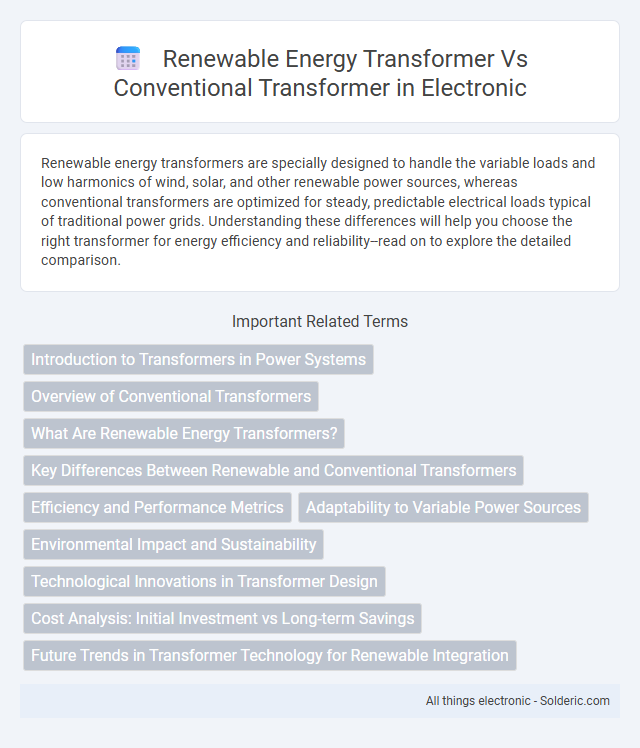Renewable energy transformers are specially designed to handle the variable loads and low harmonics of wind, solar, and other renewable power sources, whereas conventional transformers are optimized for steady, predictable electrical loads typical of traditional power grids. Understanding these differences will help you choose the right transformer for energy efficiency and reliability--read on to explore the detailed comparison.
Comparison Table
| Feature | Renewable Energy Transformer | Conventional Transformer |
|---|---|---|
| Purpose | Optimized for renewable sources like solar, wind | Designed for traditional grid power distribution |
| Efficiency | High efficiency at variable loads | Moderate efficiency, optimized for steady loads |
| Cooling System | Advanced cooling for fluctuating power | Standard cooling methods |
| Size & Weight | Typically compact, lightweight for integration | Bulkier and heavier |
| Features | Smart monitoring, low noise, eco-friendly materials | Basic monitoring, higher noise levels |
| Cost | Higher initial cost, lower maintenance | Lower upfront cost, higher maintenance |
| Application | Solar farms, wind turbines, microgrids | Industrial, residential, commercial power grids |
Introduction to Transformers in Power Systems
Transformers in power systems are crucial for voltage regulation and efficient energy transmission across the grid. Renewable energy transformers are specifically designed to handle variable loads and fluctuating power inputs from sources like solar and wind, ensuring stability and minimizing losses. Your choice between renewable energy transformers and conventional transformers impacts the integration and reliability of sustainable power generation within the electrical network.
Overview of Conventional Transformers
Conventional transformers are essential components in traditional power distribution networks, designed to transfer electrical energy between circuits through electromagnetic induction. They operate efficiently at fixed frequencies and voltages typical of fossil-fuel-based power plants but often lack the adaptability required for renewable energy integration. Understanding their limitations in handling variable inputs highlights the need for advanced transformers tailored to modern renewable energy systems.
What Are Renewable Energy Transformers?
Renewable energy transformers are specialized transformers designed to handle the unique electrical characteristics and voltage fluctuations of renewable energy sources such as wind turbines and solar panels. Unlike conventional transformers, which are optimized for stable power grids, renewable energy transformers ensure efficient energy conversion and grid integration by managing variable power outputs and harmonics. These transformers also incorporate advanced cooling systems and materials to withstand environmental stresses and improve reliability in renewable energy applications.
Key Differences Between Renewable and Conventional Transformers
Renewable energy transformers are specifically designed to handle the variable voltage and frequency fluctuations common in solar and wind power systems, unlike conventional transformers that operate under steady, predictable grid conditions. Your renewable transformer often incorporates advanced cooling systems and enhanced insulation materials to maximize efficiency and reliability in harsh environmental conditions. These transformers also prioritize low losses to improve energy conversion efficiency, directly supporting sustainable power generation.
Efficiency and Performance Metrics
Renewable energy transformers are designed to handle variable power inputs from sources like wind and solar, maintaining high efficiency across fluctuating loads, unlike conventional transformers optimized for steady, predictable loads. Performance metrics such as low core loss, high load capacity, and superior thermal management make renewable energy transformers more effective in reducing energy waste and enhancing reliability in renewable grids. Your choice of transformer directly impacts energy conversion efficiency and system stability in sustainable energy applications.
Adaptability to Variable Power Sources
Renewable energy transformers are specifically designed to handle fluctuating voltage and frequency levels from sources like solar and wind, ensuring stable energy conversion despite variable input. Conventional transformers typically operate with consistent power sources, making them less adaptable to rapid changes in load or power intermittency. Advanced features such as dynamic impedance matching and enhanced cooling systems in renewable energy transformers improve their performance and longevity under variable conditions.
Environmental Impact and Sustainability
Renewable energy transformers are designed to support green technologies with reduced environmental impact by improving energy efficiency and minimizing losses associated with power conversion. Unlike conventional transformers, which often rely on materials and manufacturing processes that contribute to pollution and resource depletion, renewable energy transformers use sustainable materials and advanced cooling methods to lower carbon emissions. Your choice of renewable energy transformers promotes long-term sustainability by enabling cleaner energy distribution and reducing the ecological footprint of electric power systems.
Technological Innovations in Transformer Design
Technological innovations in renewable energy transformers include advanced cooling systems, enhanced insulation materials, and smart monitoring sensors that optimize efficiency and reliability under variable loads. Unlike conventional transformers, these designs incorporate lightweight, eco-friendly components and are built to handle fluctuations from solar and wind power sources. You can benefit from improved energy conversion and reduced maintenance costs with these cutting-edge transformer technologies.
Cost Analysis: Initial Investment vs Long-term Savings
Renewable energy transformers typically require a higher initial investment due to advanced materials and design to handle variable loads and integrate with renewable systems. Conventional transformers have lower upfront costs but may incur higher maintenance and energy losses over time. Long-term savings with renewable energy transformers arise from increased efficiency, reduced energy loss, and lower operational costs, making them more cost-effective in sustainable energy applications.
Future Trends in Transformer Technology for Renewable Integration
Future trends in transformer technology for renewable energy integration emphasize the development of smart transformers equipped with advanced sensors and IoT connectivity to enhance grid reliability and real-time monitoring. Innovations include eco-friendly transformer oils and solid-state transformers that improve efficiency and reduce losses in variable renewable energy applications. These advancements support the seamless integration of solar and wind power by managing power fluctuations and enabling bidirectional energy flow.
renewable energy transformer vs conventional transformer Infographic

 solderic.com
solderic.com